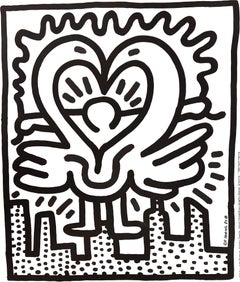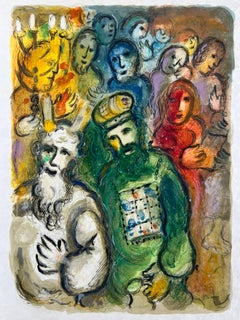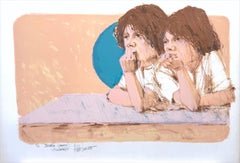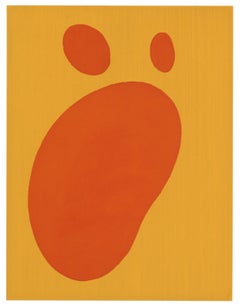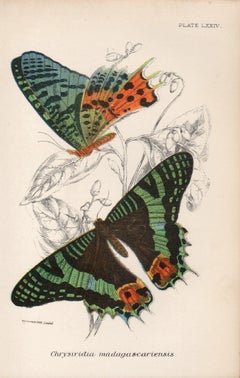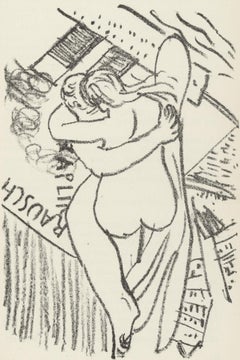Art by Medium: Lithograph
to
8,989
15,643
5,975
8,860
3,385
1,679
Overall Width
to
Overall Height
to
66
5,723
27,461
2,318
358
391
1,018
1,147
1,498
3,533
4,579
6,386
3,232
1,216
46
10,301
3,960
3,342
2,336
1,544
972
798
584
477
131
100
87
57
47
23,808
11,073
575
15,662
8,412
5,531
5,329
4,676
3,651
3,437
2,434
2,223
2,147
1,958
1,365
1,320
1,283
1,139
993
922
860
842
717
35,570
184,138
97,051
78,326
77,304
817
750
343
292
228
3,644
11,572
18,999
12,842
Medium: Lithograph
Keith Haring Kutztown Connection 1984 (Keith Haring prints posters)
By Keith Haring
Located in NEW YORK, NY
Keith Haring ‘Kutztown Connection’ 1984:
This rare vintage 1980s Keith Haring poster was illustrated by Haring in conjunction with the Benefit Performances for the New Arts Program o...
Category
1980s Pop Art Art by Medium: Lithograph
Materials
Lithograph, Offset
$640 Sale Price
20% Off
So went Moses and Aaron, and gathered all the Elders... - The Exodus
By Marc Chagall
Located in OPOLE, PL
This work will be exhibited at Art on Paper NYC, September 4–7, 2025.
–
Marc Chagall (1887-1985) - So went Moses and Aaron, and gathered all the Elders of the children of Israel
L...
Category
1960s Symbolist Art by Medium: Lithograph
Materials
Lithograph
$4,268 Sale Price
20% Off
BROTHERS Signed Lithograph, Contemporary Portrait, Two Young Boys, Peach, Brown
By Aldo Luongo
Located in Union City, NJ
BROTHERS is an original hand drawn lithograph by the Argentine artist, Aldo Luongo. Printed in 1975 at Circle Gallery NYC using traditional hand lithography methods on archival Arche...
Category
1970s Contemporary Art by Medium: Lithograph
Materials
Lithograph
(after) Jean Hans Arp - pochoir with embossing, 1958
Located in Henderson, NV
Medium: pochoir with embossing. Printed in 1958 for the art revue XXe Siecle (issue number 11) and published in Paris by San Lazzaro. Sheet size: 12 3/8 x 9 1/2 inches (315 x 242 mm)...
Category
1950s Art by Medium: Lithograph
Materials
Lithograph, Stencil
Butterflies, late 19th century antique natural history colour lithograph
Located in Melbourne, Victoria
'Chrysiridia madagascarensis'
Late 19th century colour lithograph of butterflies.
Category
Late 19th Century Victorian Art by Medium: Lithograph
Materials
Lithograph
Beckmann, Composition (Hofmaier 323-329), Der Mensch ist kein Haustier (after)
By Max Beckmann
Located in Southampton, NY
Lithograph on Van Gelder Zonen Bütten paper. Inscription: Unsigned and unnumbered, as issued. Good condition. Notes: From the volume, Der Mensch ist kein Haustier, 1937. Published by...
Category
1930s Modern Art by Medium: Lithograph
Materials
Lithograph
$1,036 Sale Price
58% Off
Lithograph n°9 - Original stone lithograph (Mourlot / Catalog raisonne BNF#53)
Located in Paris, IDF
Pierre SOULAGES
Lithograph n°9
Original stone lithograph (3 colors- atelier Mourlot)
Unsigned
On vellum 12 x 10" (31 x 24 cm)
REFERENCES : Catalogue raisonné BNF #53
Created in 19...
Category
1950s Abstract Art by Medium: Lithograph
Materials
Lithograph
Original "Keep Him Free, Buy War Savings Stamps" excellent vintage WW1 poster
Located in Spokane, WA
Original WW1 US propaganda poster designed by Charles Livingston Bull (1874-1932) and entitled “Keep Him Free Buy War Savings Stamps”. This poster was issued to promote the US Treasu...
Category
1910s American Modern Art by Medium: Lithograph
Materials
Lithograph
Alexander Calder, Untitled, from Derriere le miroir, 1966
Located in Southampton, NY
This exquisite lithograph by Alexander Calder (1898–1976), titled Sans titre (Untitled), from the folio Derriere le miroir, No. 156, originates from the 1966 edition published by Mae...
Category
1960s Modern Art by Medium: Lithograph
Materials
Lithograph
$716 Sale Price
20% Off
Miró, Composition (Mourlot 238; Cramer 39) (after)
By Joan Miró
Located in Southampton, NY
Lithograph on vélin paper. Inscription: Unsigned and unnumbered, as issued. Good condition, with centerfold, as issued. Notes: From volume, Joan Miro by Jacques Prévert and Georges R...
Category
1950s Surrealist Art by Medium: Lithograph
Materials
Lithograph
$716 Sale Price
20% Off
DEAUX FEMMES MAORIES ACCROUPIES
By Paul Gauguin
Located in Santa Monica, CA
PAUL GAUGUIN (French 1848 - 1903)
DEAUX FEMMES MAORIES ACCROUPIES. 1894-5 (Kornfield 26: Guerin 87 )
Zincograph (Lithograph) on smooth, cream imitation Japan paper, edition 200. Pu...
Category
1890s French School Art by Medium: Lithograph
Materials
Lithograph
$3,700 Sale Price
22% Off
Liberty Head III, Peter Max
By Peter Max
Located in Fairfield, CT
Artist: Peter Max (1937)
Title: Liberty Head III
Year: 2001
Edition: 485/500, plus proofs
Medium: Lithograph on Lustro Saxony paper
Size: 3.5 x 3 inches
Condition: Excellent
Inscript...
Category
Early 2000s Pop Art Art by Medium: Lithograph
Materials
Lithograph
$571 Sale Price
20% Off
Early Fall, Modern Lithograph by Linda Plotkin
Located in Long Island City, NY
Linda Plotkin, American (1938 - ) - Early Fall, Year: circa 1965, Medium: Lithograph on Arches, signed, titled and numbered in pencil, Edition: 16/90, Image Size: 20.5 x 20 inche...
Category
1960s Modern Art by Medium: Lithograph
Materials
Lithograph
Maravillas con Variaciones, Framed Abstract Lithograph by Joan Miro
By Joan Miró
Located in Long Island City, NY
Artist: Joan Miro, Spanish (1893 - 1983)
Title: Maravillas con Variaciones Acrosticas en el Jardin de Miro (Number 6)
Year: 1975
Medium: Lithograph, signed in the plate
Edition: 1500...
Category
1970s Modern Art by Medium: Lithograph
Materials
Lithograph
Original Molitg les Bains Pyrenees Orientales vintage French travel poster
Located in Spokane, WA
Original Molitg les Bains Vintage French Travel Poster. Santé et Beauté de la Peau. Pyrenees-Orientales. Archival linen backed in Grade A- condition, ready to frame. Slight touch...
Category
1950s Art Deco Art by Medium: Lithograph
Materials
Lithograph
Head, Expressionist Lithograph by Alberto Giacometti
Located in Long Island City, NY
Alberto Giacometti, Swiss (1901 - 1966) - Head From Derriere Le Miroir no. 127, Year: 1961, Medium: Lithograph, Edition: ~2500, Size: 15 x 11 in. (38.1 x 27.94 cm), Publisher: M...
Category
1960s Expressionist Art by Medium: Lithograph
Materials
Lithograph
1966 Vintage Lithograph Poster Antonio Frasconi Terry Dintenfass Gallery NYC
Located in Surfside, FL
Antonio Frasconi (28 April 1919 in Montevideo, Uruguay – 8 January 2013 in Norwalk, CT, USA) was an Uruguayan - American visual artist, best known for his woodcuts. He was raised in ...
Category
1960s American Modern Art by Medium: Lithograph
Materials
Lithograph
The Surrealist Animal, King Ubu - Original Lithograph (Maeght #414)
By Joan Miró
Located in Paris, IDF
Joan MIRO
The Surrealist Animal, King Ubu, 1966
Original lithograph (Atelier Mourlot, Paris)
Unsigned
Numbered / 75 copies
On Arches vellum 54 x 75 cm (c. 21.2 x 29.5 in)
REFERENCE...
Category
1960s Surrealist Art by Medium: Lithograph
Materials
Lithograph
Art Deco : The Palm Tree under the Sun, 1933 - Original Lithograph
Located in Paris, IDF
Jacques Camus
The Palm Tree under the Sun, 1933
Original lithograph and stencil
Unsigned
On paper 39 x 29 cm (c. 15.3 x 11.4 inch)
INFORMATION : This lithograph is part of the "Idé...
Category
1930s Art Deco Art by Medium: Lithograph
Materials
Lithograph, Stencil
1968 Original Serigraphy by Jean Dubuffet - Ecrits et lithographies
Located in PARIS, FR
Original Serigraphy
Jean Dubuffet, a French painter and sculptor renowned for his bold and unconventional approach to art, played a crucial role in shaping modernism and contemporar...
Category
1960s Art by Medium: Lithograph
Materials
Screen, Lithograph, Paper
Exposition "XXIIe Salon de Mai"
By Joan Miró
Located in Paris, FR
Lithograph, 1966
Handsigned by the artist in pencil and annotated "Con un abrazo de".
Artist proof
Edition : 100 ex.
Publisher : Salon de Mai
Printer : Mo...
Category
1960s Abstract Art by Medium: Lithograph
Materials
Lithograph
1968 original poster in for Cacharel by Folon - Fashion - Advertising
Located in PARIS, FR
This splendid poster was created by Jean-Michel Folon 🇧🇪 (1934-2005) who was a Belgian watercolorist, painter, printmaker and sculptor.
He notably worked on many materials and cre...
Category
1960s Art by Medium: Lithograph
Materials
Lithograph, Paper
lithograph for Florilege des amours de Ronsard
Located in Henderson, NV
Medium: lithograph (after Matisse). Printed in sanguine ink on cream laid paper from the Papeteries Casteljoux and published in Geneva by Edito-Service in 1970. This reproduces one o...
Category
1970s Art by Medium: Lithograph
Materials
Lithograph
Joan Miro, Figures Before the Sun, from Derriere le miroir, 1950
By Joan Miró
Located in Southampton, NY
This exquisite lithograph by Joan Miro (1893–1983), titled Personnages devant le soleil (Figures Before the Sun), from the folio Derriere le miroir, No. 29–30, originates from the 19...
Category
1950s Surrealist Art by Medium: Lithograph
Materials
Lithograph
$716 Sale Price
20% Off
SLOW TRAIN THROUGH ARKANSAS
Located in Portland, ME
Benton, Thomas Hart (American, 1889-1975 SLOW TRAIN THROUGH ARKANSAS. Fath . Lithograph, 1941. Edition of 250 published by Associated American Artists (A.A.A.). 9 7/8 x 12 inches (im...
Category
1940s Art by Medium: Lithograph
Materials
Lithograph
Armour 1979 Signed Limited Edition Lithograph
Located in Rochester Hills, MI
Agustin Fernandez
Armour - 1979
Print - Lithograph on Arches archival paper
Paper size 21.75'' x 29.5''
Edition: Signed in pencil, dated and marked 24/300
Agustin Fernandez is a con...
Category
1970s Art by Medium: Lithograph
Materials
Lithograph
Still-Life with Fruits - Original Lithograph
By Raoul Dufy
Located in Paris, IDF
Raoul DUFY
Still-Life with Fruits, 1953
Original Lithograph with stencil watercolor
With printed signature in the plate
On Arches vellum
28 x 37.5 cm (c. 11 x 14.8 inch)
Excellent ...
Category
1950s Modern Art by Medium: Lithograph
Materials
Lithograph
Abstract Lithograph by Rolando De Juan
Located in Long Island City, NY
Abstract Blue Square
Rolando de Juan, Argentine (1931–1989)
Date: 1971
Lithograph, signed and numbered in pencil
Edition of 120
Size: 30 in. x 23 in. (76.2 cm x 58.42 cm)
Category
1970s Abstract Expressionist Art by Medium: Lithograph
Materials
Lithograph
Cloud cars, 5/20 - figurative, playful, pop-art, lithograph, limited print
Located in Bloomfield, ON
This charmingly whimsical lithograph of a classic Toronto image—the streetcar was one of a series Charles Pachter first created in the seventies. Two electric streetcars moving away from the viewer fill the frame—in yellow and pink— hydro lines above them appear to be suspended above a large cloud. Pachter is a much-admired Canadian artistic polymath, his colourful pop artwork merging playful even irreverent elements with deeply iconic imagery. Number 5 0f 20.
“…and a good art critic would compare it with Warhol’s soup cans...
Category
1970s Contemporary Art by Medium: Lithograph
Materials
Lithograph
Black Birds - Lithograph - 1956
Located in Paris, IDF
(after) Georges Braque, (1882 - 1963)
Les Oiseaux Noirs (Black Birds), 1956
Lithograph
Printed in Jacomet workshop
On vellum 40 x 48 cm (c. 16 x 19 inc...
Category
1950s Cubist Art by Medium: Lithograph
Materials
Lithograph
L'Andalouise au Temps des Maures
By Jules Chéret
Located in Spokane, WA
Original L'Andalouise au Temps des Maures vintage art nouveau poster.
L'Andalousie au Temps des Maures. Exposition de 1900.
Imprimerie C...
Category
1890s Art Nouveau Art by Medium: Lithograph
Materials
Lithograph
$2,920 Sale Price
20% Off
Four Red, Three Black, One Yellow - Original Lithograph
Located in Paris, IDF
Alexander CALDER (1898-1976)
Four red, three black, one yellow
Original lithograph, 1967
Unsigned and unnumbered
Aside the edition of 90 copies numbered and hand signed
On Lana vell...
Category
1960s Abstract Art by Medium: Lithograph
Materials
Lithograph
Pablo Picasso Estate Hand Signed Fauvist Lithograph Woman Portrait Marie Therese
Located in Surfside, FL
Pablo Picasso (after)
"Portrait de Marie Therese"
limited edition print on Arches paper,
Hand signed by Marina Picasso lower right and numbered 274/500 lower left
From the estate of Pablo Picasso with an embossed blindstamp in the lower right side of the piece.
After Pablo Picasso's death in 1973, his granddaughter Marina authorized the printing of these original lithographs, which have come to be known as the Picasso Estate Collection. The lithographs were meticulously created after the original works (Oil Paintings, Watercolors, Pastels, Charcoal Drawings, etc.) by Master Chromist Marcel Salinas, who worked closely with Picasso in his lifetime. They are printed in an edition of 500 on Arches paper. Embossed with the estate and chromist's stamp seals, along with the legend on the reverse "Approved by the heirs of Pablo Picasso".
Image: 19 1/2" x 15". Paper: 28" x 20 3/4".
Pablo Ruiz Picasso (1881 – 1973) was a Spanish painter, sculptor, printmaker, ceramicist, stage designer, poet and playwright who spent most of his adult life in France. Regarded as one of the most influential artists of the 20th century, he is known for co-founding the Cubist movement, the invention of constructed sculpture, the co-invention of collage, and for the wide variety of styles that he helped develop and explore. Among his most famous works are the proto-Cubist Les Demoiselles d'Avignon (1907), and Guernica (1937), a dramatic portrayal of the bombing of Guernica by the German and Italian air forces during the Spanish Civil War...
Category
20th Century Modern Art by Medium: Lithograph
Materials
Lithograph
Dendrobium Albo-Sanguineum, antique orchid botanical lithograph print, 1859
Located in Melbourne, Victoria
'Dendrobium Albo-Sanguineum – White and Sanguine Dendrobium'
Orchid lithograph with original hand-colouring , 1859, by Walter Hood Fitch (1817-1892).
25c...
Category
Mid-19th Century Naturalistic Art by Medium: Lithograph
Materials
Lithograph
Miro, Sculptures et Ceramics, 1973 Fondation Maeght
By Joan Miró
Located in Fairfield, CT
Artist: After Joan Miro (1893-1983)
Title: Sculptures et Ceramics
Year: 1973
Medium: Lithograph exhibition poster on wove paper
Size: 32.5 x 22 inches
Condition: Excellent
Notes: Pub...
Category
1970s Surrealist Art by Medium: Lithograph
Materials
Lithograph
$636 Sale Price
20% Off
Original travel poster by Diego Rivera - Mexico Mural of national Palace
By Diego Rivera
Located in PARIS, FR
This striking mid-century travel poster celebrates the cultural richness of Mexico through the unmistakable art of Diego Rivera, one of the most influential muralists of the 20th cen...
Category
1950s Art by Medium: Lithograph
Materials
Paper, Lithograph
Haggadah of Passover, Suite of Folk Art 13 Lithographs by Shlomo Katz 1978
By Shlomo Katz
Located in Long Island City, NY
Artist: Shlomo Katz, Polish/Israeli (1937 - 1992)
Date: 1978
Set of 13 Lithographs, signed in pencil
Edition size: 350
Image Size: 23 x 18 inches
Size: 29 x 21 in. (73.66 x 53.34 cm)
Category
1970s Folk Art Art by Medium: Lithograph
Materials
Lithograph
Original 1967 exhibition poster Museum of contemporary art Chicago
Located in PARIS, FR
This is an original 1967 exhibition poster designed by Sherman Mutchnick for the Museum of Contemporary Art in Chicago, announcing the influential show “Pictures to be Read / Poetry ...
Category
1960s Art by Medium: Lithograph
Materials
Paper, Lithograph
Henri Matisse, Series B, Var. 1, Drawings, Themes and Variations, 1943 (after)
Located in Southampton, NY
This exquisite lithograph after Henri Matisse (1869–1954), titled Serie B, var. 1 (Series B, Variation 1), from the album Henri Matisse, Dessins, Themes et Variations (Drawings, Them...
Category
1940s Fauvist Art by Medium: Lithograph
Materials
Lithograph
$796 Sale Price
20% Off
Versailles (France) original lithograph vintage SNCF travel poster
Located in Spokane, WA
Original Versailles, France vintage lithograph French travel poster. Printed by the French National Railroad, SNCF in the 1938's. Printer: Goossens.
A poster fit for a king since he once resided here at Versailles. Transform your living space with the elegance and grandeur of the Versailles Original Poster. This exquisite piece captures the breathtaking beauty of the iconic Palace of Versailles, showcasing its majestic fountains and lush gardens. The vibrant colors and intricate details bring to life the opulence and historical significance of one of the world's most renowned landmarks.
The grand fountains had a chariot and horses...
Category
1930s Expressionist Art by Medium: Lithograph
Materials
Lithograph
Vase of Flowers, Peter Max
By Peter Max
Located in Fairfield, CT
Artist: Peter Max (1937)
Title: Vase of Flowers
Year: 1979
Edition: 138/350, plus proofs
Medium: Lithograph on Somerset paper
Size: 30 x 22 inches
Condition: Excellent
Inscription: S...
Category
1970s Pop Art Art by Medium: Lithograph
Materials
Lithograph
$876 Sale Price
20% Off
1983 Jack Perlmutter 'American Dance Festival 1983'
By Jack Perlmutter
Located in Brooklyn, NY
Paper Size: 30 x 22 inches ( 76.2 x 55.88 cm )
Image Size: 30 x 22 inches ( 76.2 x 55.88 cm )
Framed: No
Condition: A-: Near Mint, very light signs of handling
Additional Detai...
Category
1980s Contemporary Art by Medium: Lithograph
Materials
Lithograph
$100 Sale Price
20% Off
Henri Matisse, Miss A.N. Annelies, from Portraits by Henri Matisse, 1954 (after)
Located in Southampton, NY
This exquisite lithograph after Henri Matisse (1869–1954), titled Mademoiselle A.N. (Miss A.N.), from the album Portraits par Henri Matisse (Portraits by Henri Matisse), originates f...
Category
1950s Fauvist Art by Medium: Lithograph
Materials
Lithograph
$716 Sale Price
20% Off
Georges Braque, Bird on Background of X, San Lazzaro et ses Amis, 1975 (after)
Located in Southampton, NY
This exquisite lithograph after Georges Braque (1882–1963), titled Oiseau sur fond de X (Bird on Background of X), from the album San Lazzaro et ses Amis, Hommage au fondateur de la revue XXe siecle (San Lazzaro and His Friends, Tribute to the Founder of the Journal XXe Siecle), originates from the 1975 edition published by XXe siecle, Paris, and printed by Mourlot Freres, Paris, October 1975. Oiseau sur fond de X exemplifies Braque’s late-career mastery of poetic symbolism and formal harmony. The composition’s abstracted bird—one of Braque’s most enduring motifs—emerges from an intricate background of interlocking shapes and textures, expressing his lifelong fascination with balance, serenity, and the unity between nature and form.
Executed as a lithograph on velin d'Arches paper, this work measures 10.5 x 14 inches (26.67 x 35.56 cm). Unsigned and unnumbered as issued. The edition reflects the exceptional craftsmanship of Mourlot Freres, the legendary Parisian atelier known for its collaborations with Braque, Picasso, Chagall, and Matisse.
Artwork Details:
Artist: After Georges Braque (1882–1963)
Title: Oiseau sur fond de X (Bird on Background of X), from San Lazzaro et ses Amis, Hommage au fondateur de la revue XXe siecle, 1975
Medium: Lithograph on velin d'Arches paper
Dimensions: 10.5 x 14 inches (26.67 x 35.56 cm)
Inscription: Unsigned and unnumbered as issued
Date: 1975
Publisher: XXe siecle, Paris
Printer: Mourlot Freres, Paris
Catalogue raisonne references: Vallier, Dora, et al. Braque, the Complete Graphics: Catalogue Raisonne. Translated by Robert Bononno, Gallery Books, 1988, illustration 122.
Condition: Well preserved, consistent with age and medium
Provenance: From the album San Lazzaro et ses Amis, Hommage au fondateur de la revue XXe siecle, published by XXe siecle, Paris, October 1975
Notes:
Excerpted from the folio (translated from French), Finished printing in Paris in October 1975. This album has been printed on velin d'Arches in DLXXV numbered examples. The LXXV original examples include a series of VIII original lithographs, signed and numbered by the artists. In addition, LV examples were printed for artists, authors, friends and collaborators of XXe siecle. The typography is from l'Imprimerie Union in Paris; the lithographs of Max Bill, Marc Chagall, Hans Hartung, Braque, Fontana, Magnelli, Picasso, Magritte and Poliakoff were printed by Fernand Mourlot in Paris; those of Alexander Calder and Joan Miro by l'imprimerie Arte in Paris; that of Max Ernst by Pierre Chave in Vence; that of Zao Wou-Ki by ateliers Bellini in Paris; and that of Henry Moore by the Curwen Studio in London.
About the Publication:
San Lazzaro et ses Amis, Hommage au fondateur de la revue XXe siecle (San Lazzaro and His Friends, Tribute to the Founder of the Journal XXe Siecle), published in 1975 by XXe siecle, Paris, was conceived as a landmark tribute to Gualtieri di San Lazzaro, the visionary founder of the celebrated art journal XXe Siecle. The folio unites original lithographs by leading masters of modern art—Braque, Picasso, Chagall, Miro, Calder, Hartung, Moore, and others—printed by premier Parisian ateliers including Mourlot, Arte, Bellini, and Curwen. Representing the creative spirit and internationalism of postwar modernism, this edition stands as one of the great artistic collaborations of the 20th century.
About the Artist:
Georges Braque (1882–1963) was a French painter, printmaker, sculptor, and collagist whose visionary innovations and lifelong pursuit of balance, structure, and poetic form made him one of the most influential figures in 20th-century art. Born in Argenteuil-sur-Seine and raised in Le Havre, Braque began as a decorative painter before studying at the Ecole des Beaux-Arts and the Academie Humbert in Paris, where he absorbed the vibrant colorism of the Fauves and the structural logic of Paul Cezanne. His encounter with Pablo Picasso in 1907 led to one of the most groundbreaking collaborations in art history—the invention of Cubism—a movement that redefined visual perception by fragmenting form, rejecting single-point perspective, and reconstructing reality into a multidimensional experience. Between 1908 and 1914, Braque and Picasso revolutionized painting through Analytical Cubism, a style characterized by muted palettes, overlapping planes, and a focus on underlying structure rather than surface appearance. In 1912, Braque pioneered papier colle, the first use of collage in fine art, incorporating wallpaper and printed paper into his compositions and forever changing the relationship between art and the material world. After World War I, he returned to painting with renewed sensitivity, developing a lyrical and introspective form of Synthetic Cubism distinguished by harmony, rhythm, and a meditative sense of stillness. His still lifes, musical instruments, and interior scenes became metaphors for balance and contemplation, uniting intellect and emotion in perfect equilibrium. Immersed in the Parisian avant-garde, Braque worked alongside and exchanged ideas with Pablo Picasso, Alexander Calder, Alberto Giacometti, Salvador Dali, Joan Miro, Wassily Kandinsky, Marcel Duchamp, and Man Ray, each of whom shared his passion for redefining the boundaries of modern art. His innovations in form, collage, and spatial construction deeply influenced later artists, including Jean Dubuffet, Nicolas de Stael, Henry Laurens, Ellsworth Kelly, Richard Diebenkorn, and Jasper Johns, shaping the course of postwar abstraction and modern design. In 1961, Braque became the first living artist to have a solo exhibition at the Louvre, a recognition of his monumental impact on modern aesthetics. His works are now housed in major museums worldwide, including the Museum of Modern Art in New York, the Tate Modern in London, and the Centre Pompidou in Paris, and remain sought after for their intellectual depth and timeless serenity. His highest auction record was achieved by Paysage a la Ciotat, which sold for $15.8 million at Sotheby’s, New York, in 2013, reaffirming Georges Braque’s legacy as one of the founding architects of Cubism and a master whose art continues to define the modern age.
Georges Braque Oiseau...
Category
1970s Cubist Art by Medium: Lithograph
Materials
Lithograph
$956 Sale Price
20% Off
Interior of the Temple Abu Simbel, Egypt: A 19th C. Lithograph by David Roberts
Located in Alamo, CA
This is an original 19th century duotone lithograph entitled "Interior of the Temple of Aboo Simbel" by David Roberts, from his Egypt and Nubia volumes of the large folio edition, pu...
Category
1840s Realist Art by Medium: Lithograph
Materials
Lithograph
Marc Chagall, Flower Quay, from Derriere le miroir, 1954
By Marc Chagall
Located in Southampton, NY
This exquisite lithograph by Marc Chagall (1887–1985), titled Quai de fleurs (Flower Quay), from the folio Derriere le miroir, No. 67–68, originates from the 1954 edition published b...
Category
1950s Expressionist Art by Medium: Lithograph
Materials
Lithograph
$7,196 Sale Price
20% Off
Butterflies, late 19th century antique natural history colour lithograph
Located in Melbourne, Victoria
'1. Heliconius erato 2. Heliconus vesta 3. Heliconus sylvanus'
Late 19th century colour lithograph of butterflies.
Category
Late 19th Century Victorian Art by Medium: Lithograph
Materials
Lithograph
LeRoy Neiman "Polo Lounge" - Signed, Framed, Large - Find the Movie Stars!
By LeRoy Neiman
Located in New Orleans, LA
This is a signed press proof of one of Leroy Neiman's coolest images, created originally for Playboy Magazine in two panels. This never fails to get guests' attention on the wall, as...
Category
1980s Impressionist Art by Medium: Lithograph
Materials
Lithograph
$5,625 Sale Price
25% Off
"Pantomime", Lithograph Cover from Derriere Le Miroir by Marc Chagall
By Marc Chagall
Located in Long Island City, NY
Artist: Marc Chagall, Russian/French (1887 - 1985)
Title: Pantomime from Derriere Le Miroir (cover)
Year: 1972
Medium: Lithograph, signed in the plate
Image Size: 14.25 x 10.5 in. (3...
Category
1960s Modern Art by Medium: Lithograph
Materials
Lithograph
Falcucci's 1929 Original advertising poster Veuve Amiot Grands Vins Mousseux
Located in PARIS, FR
Step into the enchanting world of vintage poster art, where Robert Falcucci's 1929 masterpiece for Veuve Amiot Grands Vins Mousseux captures a moment of shared elegance and romance. This poster not only celebrates the allure of sparkling wine but also showcases the artistic finesse of its creator, Robert Falcucci.
Robert Falcucci, a celebrated French poster artist, was renowned for his ability to infuse his creations with sophistication and timeless charm. His artwork often celebrated life's pleasures, and the 1929 poster...
Category
1920s Art Deco Art by Medium: Lithograph
Materials
Lithograph, Paper, Linen
Ethel Katz, Fur Tailors, New Deal-era lithograph of sweatshop
Located in New York, NY
This is a classic New-Deal image: claustrophobic sweatshop with a row of hunched tailors. The windows and lamps offer light at least. But there is a major difference between this and...
Category
1930s American Modern Art by Medium: Lithograph
Materials
Lithograph
Galerie Dina Vierny after Henri Matisse, 1982
Located in New York, NY
This photo-lithographic poster was printed at the Atelier Mourlot in Paris in 1982 with the permission of the Matisse estate to promote the works by Henri Matisse at the Galerie Dina...
Category
1980s Abstract Impressionist Art by Medium: Lithograph
Materials
Lithograph
Original Marc Chagall Peintures Bibliques Recentes Jacob's Ladder exhibition
Located in Spokane, WA
Marc Chagall, Vintage Exhibition Poster (1977) — 30 × 20.5 in — Very Good, A-
Lithography poster (Mourlot workshop). Expertly printed in Paris by the renowned Mourlot Printers.
Engra...
Category
1970s Surrealist Art by Medium: Lithograph
Materials
Lithograph
Panorama de St.Tropez by Bernard Buffet, 1979
Located in New York, NY
Artist: Bernard Buffet
Medium: Original Lithograph, 1979
Dimensions: 21.5 x 29.75 in, 54.6 x 75.6 cm
classic Poster paper - Perfect Condition A+
This original lithograph by Berna...
Category
1970s Art by Medium: Lithograph
Materials
Lithograph
Original Americans All! Honor Roll - Victory Libery Loan vintage poster
Located in Spokane, WA
Original 1919 Vintage "Americans All!" Victory Liberty Loan Poster by Howard Chandler Christy. Archival linen backed in A- condition, ready to frame.
This iconic 1919 "American...
Category
1910s American Modern Art by Medium: Lithograph
Materials
Lithograph
"La cheminée" pochoir
Located in Henderson, NV
Medium: pochoir (after the painting). Printed in 1962 in a limited edition of 200 for the scarce Braque 20 Pochoirs portfolio, published in Milan by Silvana Editoriale d'Arte. Image ...
Category
1960s Art by Medium: Lithograph
Materials
Lithograph, Stencil
Surrealist Garden - Original Lithograph, Signed in the Plate - Mourlot 950
By Joan Miró
Located in Paris, IDF
Joan Miro
Surrealist Garden (Sculptures), c. 1974
Original lithograph
Signed in the plate
On Arches vellum, size 54 x 76 cm (c. 21 x 30 inch)
REFERENCE : catalog raisonne "Miro lit...
Category
Late 20th Century Abstract Art by Medium: Lithograph
Materials
Lithograph
Grapin fait le bon vin original French vintage poster
By Leon Dupin
Located in Spokane, WA
Original vintage 1933 poster: Graphin. The silhouette of the man is sitting on a casket of wine with a big bottle of wine resting on the ground in front ...
Category
1930s Art Deco Art by Medium: Lithograph
Materials
Lithograph
Senorita Rio (from One Cent Life)
By Mel Ramos
Located in Austin, TX
Artist: Mel Ramos
Title: Senorita Rio (from One Cent Life)
Series: One Cent Life
Year: 1964
Medium: Lithograph
Dimensions: 16.25 x 23"
Provenance: Private Collection, Berlin
Origin...
Category
1960s Pop Art Art by Medium: Lithograph
Materials
Lithograph
$455 Sale Price
30% Off
Classic Blue Silk Movement, Abstract Fabric Gestures, Contemporary Cyanotype
By Kind of Cyan
Located in Barcelona, ES
This is an exclusive handprinted limited edition cyanotype.
Details:
+ Title: Classic Blue Silk Movement nº1
+ Year: 2024
+ Edition Size: 100
+ Medium: Cyanotype Print on Watercolor Paper
+ Stamped and Certificate of Authenticity provided
+ Measurements : 70x100 cm (28x 40 in.), a standard frame size
+ All cyanotype prints are made on high-quality Italian watercolor paper
WHAT IS A CYANOTYPE?
The cyanotype (a.k.a. sun-print) process is one of the oldest in the history of photography, dating back to the 1840's.
Cyanotypes were then made famous by Anna Atkins...
Category
2010s Op Art Art by Medium: Lithograph
Materials
Lithograph
Lithograph art for sale on 1stDibs.
Find a wide variety of authentic Lithograph art available on 1stDibs. While artists have worked in this medium across a range of time periods, art made with this material during the 21st Century is especially popular. If you’re looking to add art created with this material to introduce a provocative pop of color and texture to an otherwise neutral space in your home, the works available on 1stDibs include elements of blue, orange, yellow, red and other colors. There are many well-known artists whose body of work includes ceramic sculptures. Popular artists on 1stDibs associated with pieces like this include Joan Miró, Marc Chagall, Peter Max, and Alexander Calder. Frequently made by artists working in the Modern, Contemporary, all of these pieces for sale are unique and many will draw the attention of guests in your home. Not every interior allows for large Lithograph art, so small editions measuring 0.01 inches across are also available
